管理学问答题
- 格式:doc
- 大小:374.00 KB
- 文档页数:71
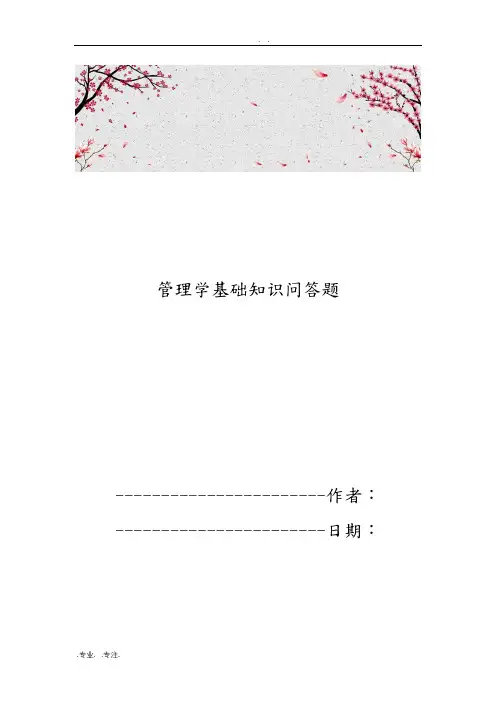
管理学基础知识问答题-----------------------作者:-----------------------日期:重点知识汇总1管理学是系统的研究人类管理活动的普遍规律,基本原理和一般方法的科学,从纵向看可分为古代管理学、近代管理学、现代管理学2现代管理学的特征二重性、动态性、创造性艺术性3现代管理的研究方法历史比较法、个案分析法、心理研究法、归纳演绎法4泰罗的科学管理思想核心目的提高工作效率。
容:劳动定额、第一流工人制、标准化管理、刺激性工资制、思想革命、计划与执行分离的思想、职能长工制、管理对外原则5法约尔的一般管理思想重点在于分析高层管理效率和一般管理原则6韦伯的行政管理思想(组织理论之父)7欧文关注环境主花钱改善工作条件是最明智的投资8巴纳德管理的工作就是沟通激励9芝斯特伯格创立工业心理理论、将心理测试用于人员深造10福莱特用个人行为观点来看待组织个人行为和单体行为11梅奥的人际关系理论(霍桑试验)人际关系学说:工人是社会而不是单纯的追求金钱物质需求的经济人、企业中除了正式组织外还存在非正式组织、新型的领导在于通过对职工的满足度的增加来提高工人的士气12彼得圣古的学习型组织的理论、自我超越改善心智模式、建立共同愿景、团体学习系统思考。
具有的在特征、组织成员拥有一个共同的愿景组织由多个创造性的个体组成善于不断学习地方为主的扁平结构自主管理组织的边界将被重新界定员工家庭与事业平衡领导者的新角色13柔性管理的本质是依据人们自身心理和行为规律14 SWOT分析法就是帮助组织进行部环境的机会与威胁组织自身的优势与劣势分析并帮助组织确定与制定发展战略及其行动方案的一种外部环境的综合分析技术15履行管理职责是管理者涵义的实质和核心、管理者的主要职责有计划、决策、组织、协调、使用人才控制、监督。
管理者实行管理的基本原则和要求:以管理职责为核心做到职务职权职责的有机统一、管理的全部职务任务可分为计划组织人事领导控制16计划职能是管理过程中的首要任务他作为一条主线贯穿于管理的全过程17决策是管理的基础是计划工作的核心;决策的构成要素决策者决策目标自然状态备选方案决策后果决策准则。
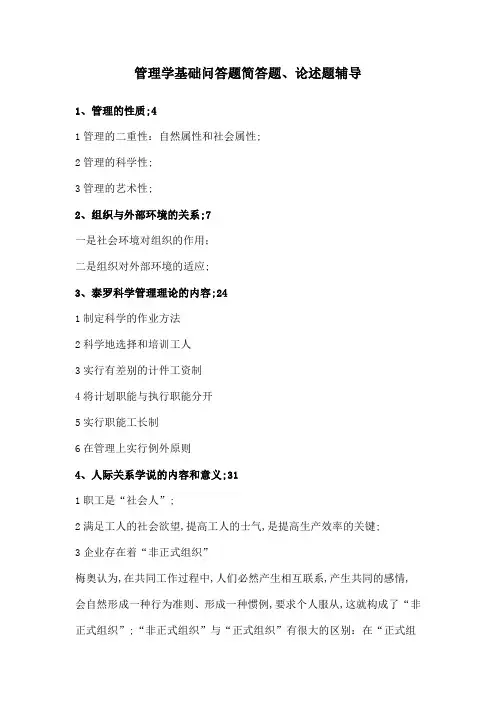
管理学基础问答题简答题、论述题辅导1、管理的性质;41管理的二重性:自然属性和社会属性;2管理的科学性;3管理的艺术性;2、组织与外部环境的关系;7一是社会环境对组织的作用;二是组织对外部环境的适应;3、泰罗科学管理理论的内容;241制定科学的作业方法2科学地选择和培训工人3实行有差别的计件工资制4将计划职能与执行职能分开5实行职能工长制6在管理上实行例外原则4、人际关系学说的内容和意义;311职工是“社会人”;2满足工人的社会欲望,提高工人的士气,是提高生产效率的关键;3企业存在着“非正式组织”梅奥认为,在共同工作过程中,人们必然产生相互联系,产生共同的感情,会自然形成一种行为准则、形成一种惯例,要求个人服从,这就构成了“非正式组织”;“非正式组织”与“正式组织”有很大的区别:在“正式组织”中是以效率的逻辑为标准,而在“非正式组织”中是以感情的逻辑为标准的;“正式组织”与“非正式组织”共同存在,相互依存,对生产效率的提高都有很大的影响;5、现代管理理论内容;33二战以后,管理思想得到了丰富和发展,形成了众多的流派,美国着名管理学家孔茨称之为“管理理论的丛林”;1管理过程学派管理过程学派的创始人是法约尔,其代表人物包括孔茨、奥唐奈,其主要观点是把管理学说与管理职能联系起来,专门研究管理过程和管理职能;2经验学派经验学派的代表人物是德鲁克、戴尔,主张通过分析经验、案例来研究管理问题;3系统管理学派系统管理学派强调以系统的观点来研究管理问题;4决策理论学派决策理论学派的代表人物是西蒙,他认为,管理就是决策:管理活动的全部过程都是决策过程,管理是以决策为特征的;决策是管理人员的主要任务,管理人员应该集中精力研究决策问题;西蒙将决策分为程序性决策和非程序性决策,他的研究重点是非程序性决策;5管理科学学派管理科学学派是运用数学模型和计算机技术来进行管理决策,以提高经济效益;6权变理论学派权变理论学派认为,管理没有绝对正确的方法,采用何种理论和方法,要视组织的实际情况而定,即所谓“权宜应变”;7、企业文化理论;37企业文化理论在20世纪80年代发源于美国,但企业文化的实践却首先在日本得到较快的发展;企业文化是指在生产经营和管理活动中所创造的具有本企业特色的精神财富及其物质形态;它由三个部分组成:1企业精神;2企业作风;3企业形象;企业文化的功能主要体现在:1企业文化对企业员工的思想和行为起着导向作用;2对企业文化具有凝聚和激励作用;3对员工行为具有约束和辐射作用;8、目标管理的实施过程;73目标管理实施过程一般可以分为目标建立、目标分解、目标控制、目标评定与考核四个阶段;1目标建立;建立企业目标首先要明确企业的使命宗旨,并结合企业内外环境决定一定期限内的工作具体目标;传统的目标设定过程是单向的,由上级给下级设定目标,即由企业领导者设定,然后分解成各级目标,最后落实到个人目标;现代管理学提倡参与制目标设定法,要求企业员工参与目标的设立;常用的有自上而下的目标制定法和自下而上的目标制定法;2目标分解;把企业的总目标分解成各部门的分目标和个人目标;要使所有员工都乐于接受企业的目标,明确自己应承担的责任;3目标控制;为保证企业目标的顺利实现,管理者必须进行目标控制,随时了解目标实施情况,及时发现问题并协助解决;必要时,也可以根据环境变化对目标进行一定的修正;积极的自我控制与有力的领导控制相结合是实现目标动态控制的关键;4目标评定与考核;目标管理注重结果,对部门及个人目标的完成情况必须进行自我评定、群众评议、领导评审;通过评价活动,肯定成绩、发现问题、及时总结目标执行过程中的成绩与不足,完善下一个目标管理过程;9、目标管理的优越性;79目标管理主要有以下优点:1能有效地提高管理的效率2能有助于企业组织机构的改革3能有效地激励职工完成企业目标4能实行有效的监督与控制,减少无效劳动10、决策及其特征;98决策是为了达到一定的目标,从两个或两个以上的可行方案中选择一个合理方案的分析判断过程;西蒙说:“决策是管理的心脏;管理是由一系列决策组成的;管理就是决策;”决策具有这样的特征:一是超前性;二是目标性;三是选择性;四是可行性;五是过程性;六是科学性;11、决策应遵循的原则;101一是满意原则;二是分级原则;三是集体和个人相结合的原则;四是定性分析和定量分析相结合的原则;五是整体效用原则;12、特尔菲法106特尔菲法是由美国着名的兰德公司首创并用于预测和决策的方法,该方法是以匿名方式通过几轮函询征求专家的意见,组织预测小组对每一轮的意见进行汇总整理后作为参考再发给各专家,供他们分析判断以提出新的论证;几轮反复后,专家意见渐趋一致,最后供决策者进行决策;13、企业组织结构的含义;124企业的组织结构是企业全体职工为实现企业目标,在管理工作中进行分工协作,在职务范围、责任、权利方面所形成的结构体系;其含义可以从以下三个方面来理解:1组织结构的本质是职工的分工合作关系;2组织结构的核心内容是权责利关系的划分;3组织结构设计的出发点与依据是企业目标;14、组织工作的基本原则;1271目标任务原则;2责权利相结合的原则;3分工协作原则及精干高效原则;4管理幅度原则;5统一指挥原则和权力制衡原则;6集权与分权相结合的原则;15、事业部制组织结构的优缺点;1441特征也可称之为项目式组织结构,其结构图是M形的;最早设立事业部的是美国通用汽车公司,其发明者是管理学家斯隆和杜邦;这是一种分权式结构,它是在总公司之下设立多个事业部,事业部可以按产品、或按市场、或按地区划分,每一个事业部都有自己的产品和市场;事业部是总公司下面的一个利润中心,实行独立核算,自主经营;2优点其优点是:1权力下放,有利于高层领导集中精力研究企业的大政方针和战略问题;2各事业部独立核算,能充分发挥他们的积极性、主动性和创造性;3各事业部之间的竞争有利于提高公司的整体效率;4便于培训管理人才;3缺点其缺点是,由于在总公司和各个事业部都要设置职能结构,比如生产、销售、财务,容易造成机构重叠,管理人员膨胀,管理费用增加;另一方面,各事业部独立性强,考虑问题容易忽视整个利益,等等;16、衡量集权与分权的标志;151集权与分权是相对的,衡量一个组织集权或分权的标志主要有:1决策的数量;2决策的范围;3决策的重要性;4决策的审核;17、人员配备的基本原则;162人员配备是根据组织目标和任务正确选择、合理使用、科学考评和培训人员,以合适的人员去完成组织结构中规定的各项任务,从而保证整个组织目标和各项任务完成的职能活动;要完成人员配备的任务,就要坚持如下原则:1经济效益原则;2任人唯贤原则;3因事择人原则;4量才使用原则;5程序化、规范化原则;18、管理人员的选聘渠道;163管理人员的来源有两方面:一是从组织内部培养、选拔、任用,即内部来源;二是从组织外部招聘,即外部来源;一个组织要得到优秀的管理者,必须同时考虑内源与外源两个渠道;1内部来源优点:1他们对组织情况较为熟悉,了解与适应管理工作的过程会大大缩短,他们上任后能很快进入角色;2选任时间较为充裕,对备选对象可以进行长期考察,全面了解,对他们的长处和短处看得比较清楚,能做到用其所长,避其所短;3有利于鼓舞士气,提高工作热情,调动员工的积极性,激发他们的上进心;4手续简单,费用低;缺陷:1容易造成“近亲繁殖”;2容易在组织内部形成错综复杂的关系网,任人唯亲,拉帮结派,给公平、合理、科学的管理带来困难;3内部备选对象范围狭窄;2外部来源优点:1来源广泛,选择空间大;2可避免“近亲繁殖”,能给组织带来新鲜空气和活力,有利于组织创新和管理革新;3有利于平息和缓和内部竞争者之间的紧张关系;4可以要求应聘者有一定的学历和工作经验,因而可节省在培训方面所耗费的时间和费用;缺点:1难以准确地判断他们的实际管理才能;2费用高;3容易造成对内部员工的打击;总之,一个组织选聘管理人员是采用内源渠道还是外源渠道,要视具体情况而定;一般情况是这样的:高层主管一般采用外源渠道,基层和中层管理者可采用内源渠道;在组织成长期多用外源渠道,稳定期多用内源渠道;19、管理人员需要量的确定;1631组织规模;2业务的复杂程度;3管理部门的数目;4管理人员的储备需要;20、管理人员培训的内容;1741业务培训;2管理理论培训;3管理能力培训;4交际能力及心理素质培训;21、领导理论发展的三个阶段;1901性格理论阶段;2行为理论阶段;3权变理论阶段;22、领导的影响力;187领导是领导者向下属施加影响的行为,领导的实质在于影响;影响力由法定权力和自身影响力两方面构成;1法定权力;法定权是组织赋予领导者的岗位权力,它以服从为前提,具有明显强制性;法定权随职务的授予而开始,以职务的免除而终止;包括决策权、组织权、指挥权、人事权、奖惩权;2自身影响力;影响力是领导者以自身的威望影响或改变被领导者的心理和行为的力量;自身影响力不能由组织赋予,不具有法定性质;构成领导影响力的因素包括品德、学识、能力、情感;23、领导班子的合理构成;2021年龄结构;2知识结构;3能力结构;4专业构成;24、领导者科学用人的艺术;2071知人善任的艺术;2量才使用的艺术;3用人不疑的艺术;25、影响人际关系的因素;1职工空间距离的远近;2职工观念态度的相似性;3职工彼此交往的频率;4职工彼此需要的互补性;26、激励过程;219激励,就是“激发、鼓励”,是一种人的需要和动机得到强化的心理状态;激励实质上就是以未满足的需要为基础,利用各种目标激发产生动机,驱使和诱导行为,促使目标的实现;激励过程就是一个由需要开始,到需要得到满足为止的连锁反应过程;当人们产生需要而未得到满足时,会产生一种紧张不安的心理状态,在遇到能够满足需要的目标时,这种紧张不安的心理就转化为动机,并在动机的驱动下向目标努力,目标达到后,需要得到满足,紧张不安的心理状态就会消除;随后,又会产生新的需要,引起新的动机和行为;这就是激励过程;27、马斯洛的需要层次理论;222马斯洛认为,人是有需要的“动物”,需要产生了人的动机,需要是激励人们工作的因素;马斯洛把人类的需要分为五大类生理需要、安全的需要、归属的需要、尊重的需要、自我实现的需要,而且,可以按照需要的重要性及其先后顺序排列一个需要层次图;第一层次的需要是生理需要;包括那些维持人的生命存在的生活必需品;马斯洛认为,当这些需要还没有达到足以维持生命之前,其他的需要都不能起到激励的作用;第二层次的需要是安全的需要;比如,生活要有保障;工作要稳定;生病了、年纪大了,要有所依靠;避免人身伤害,等等;第三层次的需要是友爱和归属的需要;生理需要和安全的需要是较低层次的需要;衣食足,然后知荣辱;当生理及安全需要得到相当的满足后,友爱和归属方面的需要便开始占据主要地位;第四层次的需要是尊重的需要;人们一旦满足了归属的需要,就会产生尊重的需要,即自尊和受到别人的尊重;第五层次的需要是自我实现的需要;这是最高层次的需要,它是一种能使人发挥最大的潜能,实现自己理想的一种欲望;马斯洛认为,一般的人都是按照这个层次从低级到高级,一层一层地去追求并使自己的需要得到满足的;在某一特定的时期内,总有某一层次的需要在起着主导的激励作用;一旦这一层次的需要得到满足,那么这一层次的需要就不再是人们工作的主要动力和激励因素,人们就会追求更高一层次的需要;管理者应当根据不同人的需要层次,用他们正在追求的那一层次的需要来激励他们,将会取得极好的激励效果;28、双因素理论;223赫茨伯格把影响人类需要的因素分为两类:保健因素和激励因素:第一,有一些需要,比如:公司政策、管理、监督、工作条件、人际关系、工资、地位和职业安定以及个人生活等,如果得不到满足,会导致人们的不满;如果得到满足,则没有不满;赫茨伯格把这类和工作环境或工作条件相关的因素称为保健因素;换句话说,如果这些因素在工作环境中大量存在,而且条件优越,就不至于引起人们的不满意;而缺少这些因素,就会引起不满非有不可;这是一些保持因素,但不是激励因素;第二,另一些需要,比如:成就、责任、赏识、工作具有挑战性以及工作中的成长、晋升等,如果得到满足,会给人以极大的激励,产生满意感,有助于充分、有效、持久地调动人们的积极性;如果得不到满足,则不会产生满意感;赫茨伯格认为,这些与工作内容相关的因素,才是真正的激励因素;赫茨伯格认为,保健因素不能直接起到激励人们的作用,但能防止人们产生不满情绪;作为管理者,首先必须确保满足职工保健因素方面的需要:要给职工提供适当的工资和安全保障,要改善他们的工作环境和条件;对职工的监督要能为他们所接受,否则,就会引起职工的不满;但是,即使满足了上述条件,也不能产生激励效果,因此,管理者必须充分利用激励方面的因素,为职工创造工作的条件和机会,丰富其工作内容,增强职工的责任心,使其在工作中取得成就,得到上级和人们的赏识,这样才能促使其不断进步和发展;赫茨伯格的双因素理论与马斯洛的需要层次理论大体上是相符的;他的保健因素相当于马斯洛的较低层次的需要,而激励因素则相当于较高层次的需要;所不同的是,赫茨伯格认为,激励的功能,主要体现在对人的较高层次需要的满足上面;29、控制系统的特点;2461具有较强的环境适应性;2具有自身的目的性;3具有较强的反馈功能;30、有效控制的基本要求;2491控制工作要具有全局观点;2控制工作应面向组织的未来发展;3控制工作应确立客观标准;4控制系统应切合主管人员的个别情况;5控制工作应有纠正措施;31、全面质量管理的含义和内容;265全面质量管理,就是指企业内部的全体员工都参与到企业产品质量和工作质量工作过程中,把企业的经营管理理念、专业操作和开发技术、各种统计与会计手段方法等结合起来,在企业中普遍建立从研究开发、新产品设计、外购原材料、生产加工,到产品销售、售后服务等环节的贯穿企业生产经营活动全过程的质量管理体系;全面质量管理的内容包括两个方面:一是全员参与质量管理;二是全过程质量管理;32、企业与外部关系的协调;2811企业与消费者关系的协调;2企业与政府关系的协调;3企业与新闻界关系的协调;4企业与社区的关系;33、冲突对组织发展的作用;285冲突具有正面和反面、建设性和破坏性两种性质;没有冲突的组织将表现得呆滞,对环境变化适应慢和缺乏创新精神,因而绩效也不是最好的;而存在一定水平的冲突,可以促进组织变革,使组织充满活力,因而绩效水平可以大大提高;基于这种认识,管理者的任务不再是防止和消除冲突,而是管理好冲突,减少其不利影响,充分发挥其积极的一面;冲突到底能给组织带来哪些好处呢概括地说,有以下几个方面:1冲突可以使对抗双方采取适当方式发泄他们心中的不满,促进双方之间的沟通,避免由于长期压抑而可能发生极端状态;2冲突可以使组织内一些平时不被重视的问题充分暴露出来,使管理者及早发现并加以解决;3冲突可以促进新思想、好建议的产生,从而促进组织变革;4组织间的冲突,可以增加组织的内聚力,使组织内部成员齐心协力,一致对外;5冲突可以促进联合,以求共同生存;比如,现在经常发生的大公司之间的购并,就是为了战胜他们共同的对手而进行的联手;由于冲突对组织发展具有以上重要意义,因此,冲突成为组织协调的最基本内容;34、协调组织冲突的对策;287面对冲突,管理者可以采取一些方法加以解决:1回避:这是解决冲突的最简单的一种方法;当冲突微不足道时,或当冲突双方情绪非常激动时,可以采取让双方暂时回避的方法来加以解决;2强制解决:管理者利用职权强行解决冲突;强制解决的优点是花费时间少,一个命令解决问题;但强制解决,往往会以牺牲某一方的利益为代价;3妥协:要求冲突各方都作出一定的让步,使问题得到解决;比如说,当冲突各方势均力敌时,或者冲突双方希望就某一问题尽快取得解决办法时,可以采取这种处理方法;4树立更高目标:为冲突双方树立更高的目标,使冲突各方感到紧迫感和压力;当其中任何一方单靠自己的能力不能完成目标时,冲突双方可能会进行合作并作出一定让步,为完成目标而统一起来;5合作:将冲突各方召集到一起,让他们进行开诚布公的讨论,搞清楚分歧在哪里,并商量可能的解决办法;这种方法可以使双方的利益都得到满足,从结果来说是最好的选择;但这种方法花费时间会比较多;35、信息沟通的障碍及克服措施;2981信息沟通的障碍:第一,沟通方式选择不当,会造成沟通障碍;第二,沟通双方在技能、知识等方面的差异,会影响沟通效果;第三,态度和兴趣;第四,情绪;第五,信息过滤:故意篡改或歪曲事实,使信息接受者接受不到真实、全面的信息;2促进有效沟通的措施:第一,选择适合的沟通方式:要根据沟通内容和特点、沟通双方的特点、沟通方式的特点,选择适合的沟通方式;第二,善于运用反馈;第三,学会积极倾听;第四,建立和完善管理信息系统;。
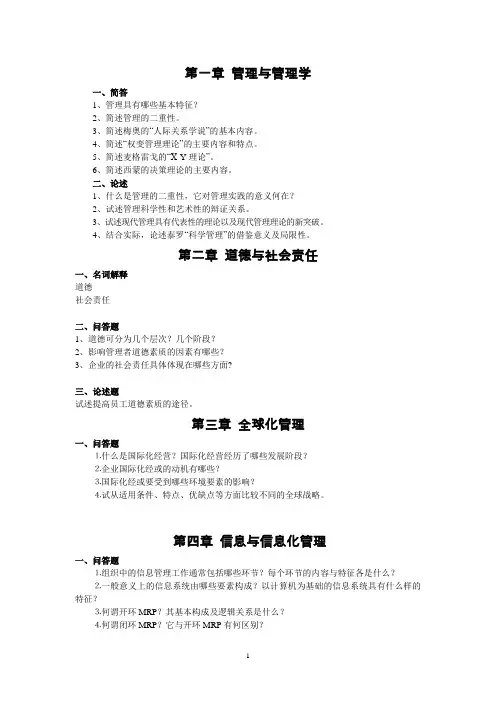
第一章管理与管理学一、简答1、管理具有哪些基本特征?2、简述管理的二重性。
3、简述梅奥的“人际关系学说”的基本内容。
4、简述“权变管理理论”的主要内容和特点。
5、简述麦格雷戈的“X-Y理论”。
6、简述西蒙的决策理论的主要内容。
二、论述1、什么是管理的二重性,它对管理实践的意义何在?2、试述管理科学性和艺术性的辩证关系。
3、试述现代管理具有代表性的理论以及现代管理理论的新突破。
4、结合实际,论述泰罗“科学管理”的借鉴意义及局限性。
第二章道德与社会责任一、名词解释道德社会责任二、问答题1、道德可分为几个层次?几个阶段?2、影响管理者道德素质的因素有哪些?3、企业的社会责任具体体现在哪些方面?三、论述题试述提高员工道德素质的途径。
第三章全球化管理一、问答题⒈什么是国际化经营?国际化经营经历了哪些发展阶段?⒉企业国际化经或的动机有哪些?⒊国际化经或要受到哪些环境要素的影响?⒋试从适用条件、特点、优缺点等方面比较不同的全球战略。
第四章信息与信息化管理一、问答题⒈组织中的信息管理工作通常包括哪些环节?每个环节的内容与特征各是什么?⒉一般意义上的信息系统由哪些要素构成?以计算机为基础的信息系统具有什么样的特征?⒊何谓开环MRP?其基本构成及逻辑关系是什么?⒋何谓闭环MRP?它与开环MRP有何区别?⒌与物料需求计划相比,制造资源计划(MRPII)有何改进?⒍与MRPII相比,ERP有何进步?第五章决策与决策方法一、简答题1.简述决策的基本过程2.简述正确决策的基本要求二、计算1.据市场预测,今后几年市场对某公司产品的需求会扩大(概率0.7),但也存在着销售量减少的可能(概率0.3),公司面临几种可能的选择:第一:扩建厂房更新设备,需投资700万元,若需求量扩大,公司每年可获利300万元;若需求量减少公司每年亏损50万元,服务期限5年。
第二:使用老厂房,更新设备,需投资400万元,若需求扩大,每年可获利100万元,若需求减少,每年也可获利60万元,服务期限5年。
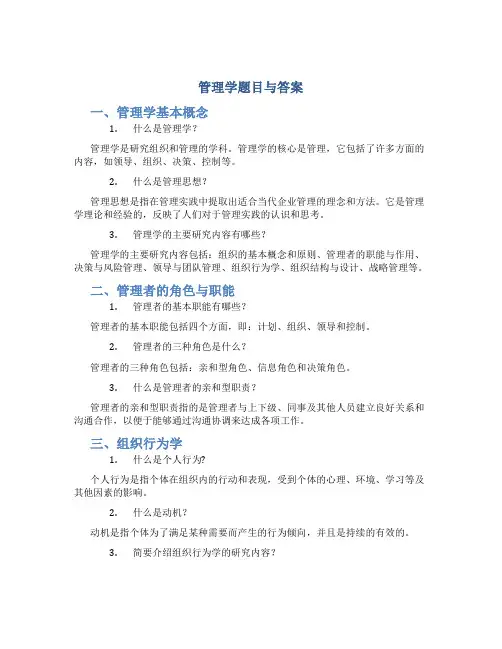
管理学题目与答案一、管理学基本概念1.什么是管理学?管理学是研究组织和管理的学科。
管理学的核心是管理,它包括了许多方面的内容,如领导、组织、决策、控制等。
2.什么是管理思想?管理思想是指在管理实践中提取出适合当代企业管理的理念和方法。
它是管理学理论和经验的,反映了人们对于管理实践的认识和思考。
3.管理学的主要研究内容有哪些?管理学的主要研究内容包括:组织的基本概念和原则、管理者的职能与作用、决策与风险管理、领导与团队管理、组织行为学、组织结构与设计、战略管理等。
二、管理者的角色与职能1.管理者的基本职能有哪些?管理者的基本职能包括四个方面,即:计划、组织、领导和控制。
2.管理者的三种角色是什么?管理者的三种角色包括:亲和型角色、信息角色和决策角色。
3.什么是管理者的亲和型职责?管理者的亲和型职责指的是管理者与上下级、同事及其他人员建立良好关系和沟通合作,以便于能够通过沟通协调来达成各项工作。
三、组织行为学1.什么是个人行为?个人行为是指个体在组织内的行动和表现,受到个体的心理、环境、学习等及其他因素的影响。
2.什么是动机?动机是指个体为了满足某种需要而产生的行为倾向,并且是持续的有效的。
3.简要介绍组织行为学的研究内容?组织行为学研究关注的是组织的内部关系和个人行为。
其研究内容包括个人行为、团队行为、协作和沟通、组织文化、能力培养和发展等。
四、团队管理1.团队的特征是什么?团队的特征包括目标协调、成员互补、互惠互利等。
2.团队管理的基本理念是什么?团队管理的基本理念是以人为本,实现个人和团队互利共赢。
3.团队的决策模式有哪些?团队的决策模式包括:一致性决策模式、集思广益决策模式、独裁决策模式等。
五、领导力1.什么是领导力?领导力是指通过口头和行动激励他人,达到共同的目标,在推动团队协同工作和创造性思维方面发挥重要作用。
2.领导力的五种基本行为是什么?领导力的五种基本行为是:塑造愿景、提供指导、赋予权力、打造团队以及展示榜样作用。
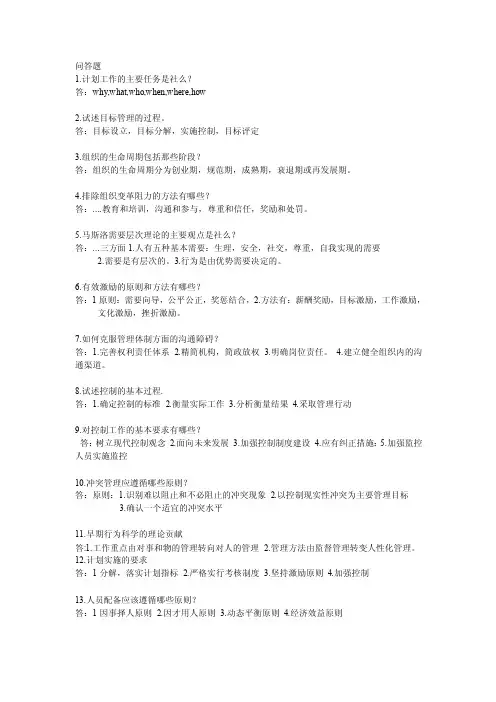
1.计划工作的主要任务是社么?答:why,what,who,when,where,how2.试述目标管理的过程。
答:目标设立,目标分解,实施控制,目标评定3.组织的生命周期包括那些阶段?答:组织的生命周期分为创业期,规范期,成熟期,衰退期或再发展期。
4.排除组织变革阻力的方法有哪些?答:....教育和培训,沟通和参与,尊重和信任,奖励和处罚。
5.马斯洛需要层次理论的主要观点是社么?答:...三方面1.人有五种基本需要:生理,安全,社交,尊重,自我实现的需要2.需要是有层次的。
3.行为是由优势需要决定的。
6.有效激励的原则和方法有哪些?答:1原则:需要向导,公平公正,奖惩结合,2.方法有:薪酬奖励,目标激励,工作激励,文化激励,挫折激励。
7.如何克服管理体制方面的沟通障碍?答:1.完善权利责任体系 2.精简机构,简政放权 3.明确岗位责任。
4.建立健全组织内的沟通渠道。
8.试述控制的基本过程.答:1.确定控制的标准 2.衡量实际工作3.分析衡量结果4.采取管理行动9.对控制工作的基本要求有哪些?答:树立现代控制观念2.面向未来发展3.加强控制制度建设4.应有纠正措施:5.加强监控人员实施监控10.冲突管理应遵循哪些原则?答:原则:1.识别难以阻止和不必阻止的冲突现象 2.以控制现实性冲突为主要管理目标3.确认一个适宜的冲突水平11.早期行为科学的理论贡献答:1.工作重点由对事和物的管理转向对人的管理 2.管理方法由监督管理转变人性化管理。
12.计划实施的要求答:1分解,落实计划指标 2.严格实行考核制度3.坚持激励原则4.加强控制13.人员配备应该遵循哪些原则?答:1因事择人原则 2.因才用人原则3.动态平衡原则4.经济效益原则1.柔性管理是指以人的心里和行为的规律为实施依据........管理方式和方法2.组织变革是组织为了适应组织外部环境的变化....进行调整和修正。
3.人本管理是指在管理活动中,始终把人放在中心的位置......组织效益的最优化。
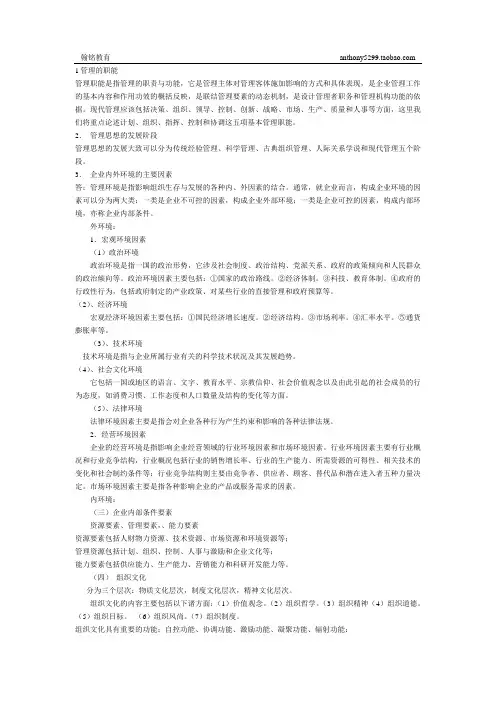
管理职能是指管理的职责与功能,它是管理主体对管理客体施加影响的方式和具体表现,是企业管理工作的基本内容和作用功效的概括反映,是联结管理要素的动态机制,是设计管理者职务和管理机构功能的依据。
现代管理应该包括决策、组织、领导、控制、创新、战略、市场、生产、质量和人事等方面,这里我们将重点论述计划、组织、指挥、控制和协调这五项基本管理职能。
2.管理思想的发展阶段管理思想的发展大致可以分为传统经验管理、科学管理、古典组织管理、人际关系学说和现代管理五个阶段。
3.企业内外环境的主要因素答:管理环境是指影响组织生存与发展的各种内、外因素的结合。
通常,就企业而言,构成企业环境的因素可以分为两大类:一类是企业不可控的因素,构成企业外部环境;一类是企业可控的因素,构成内部环境,亦称企业内部条件。
外环境:1.宏观环境因素(1)政治环境政治环境是指一国的政治形势,它涉及社会制度、政治结构、党派关系、政府的政策倾向和人民群众的政治倾向等。
政治环境因素主要包括:①国家的政治路线。
②经济体制。
③科技、教育体制。
④政府的行政性行为,包括政府制定的产业政策、对某些行业的直接管理和政府预算等。
(2)、经济环境宏观经济环境因素主要包括:①国民经济增长速度。
②经济结构。
③市场利率。
④汇率水平。
⑤通货膨胀率等。
(3)、技术环境技术环境是指与企业所属行业有关的科学技术状况及其发展趋势。
(4)、社会文化环境它包括一国或地区的语言、文字、教育水平、宗教信仰、社会价值观念以及由此引起的社会成员的行为态度,如消费习惯、工作态度和人口数量及结构的变化等方面。
(5)、法律环境法律环境因素主要是指会对企业各种行为产生约束和影响的各种法律法规。
2.经营环境因素企业的经营环境是指影响企业经营领域的行业环境因素和市场环境因素。
行业环境因素主要有行业概况和行业竞争结构,行业概况包括行业的销售增长率、行业的生产能力、所需资源的可得性、相关技术的变化和社会制约条件等;行业竞争结构则主要由竞争者、供应者、顾客、替代品和潜在进入者五种力量决定。
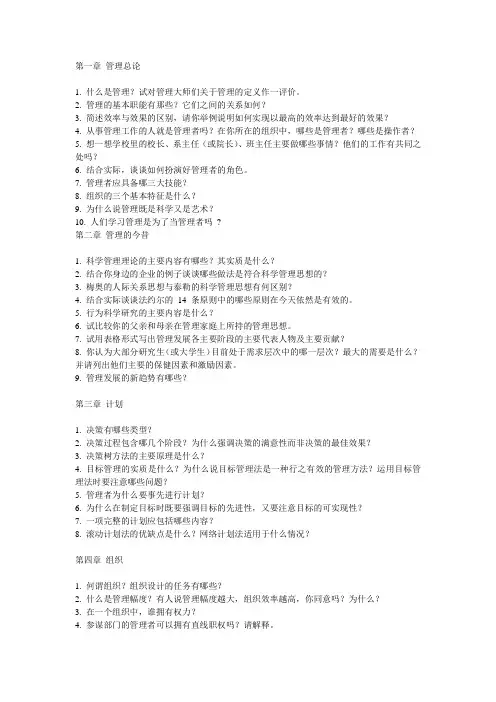
第一章管理总论1. 什么是管理?试对管理大师们关于管理的定义作一评价。
2. 管理的基本职能有那些?它们之间的关系如何?3. 简述效率与效果的区别,请你举例说明如何实现以最高的效率达到最好的效果?4. 从事管理工作的人就是管理者吗?在你所在的组织中,哪些是管理者?哪些是操作者?5. 想一想学校里的校长、系主任(或院长)、班主任主要做哪些事情?他们的工作有共同之处吗?6. 结合实际,谈谈如何扮演好管理者的角色。
7. 管理者应具备哪三大技能?8. 组织的三个基本特征是什么?9. 为什么说管理既是科学又是艺术?10. 人们学习管理是为了当管理者吗?第二章管理的今昔1. 科学管理理论的主要内容有哪些?其实质是什么?2. 结合你身边的企业的例子谈谈哪些做法是符合科学管理思想的?3. 梅奥的人际关系思想与泰勒的科学管理思想有何区别?4. 结合实际谈谈法约尔的14 条原则中的哪些原则在今天依然是有效的。
5. 行为科学研究的主要内容是什么?6. 试比较你的父亲和母亲在管理家庭上所持的管理思想。
7. 试用表格形式写出管理发展各主要阶段的主要代表人物及主要贡献?8. 你认为大部分研究生(或大学生)目前处于需求层次中的哪一层次?最大的需要是什么?并请列出他们主要的保健因素和激励因素。
9. 管理发展的新趋势有哪些?第三章计划1. 决策有哪些类型?2. 决策过程包含哪几个阶段?为什么强调决策的满意性而非决策的最佳效果?3. 决策树方法的主要原理是什么?4. 目标管理的实质是什么?为什么说目标管理法是一种行之有效的管理方法?运用目标管理法时要注意哪些问题?5. 管理者为什么要事先进行计划?6. 为什么在制定目标时既要强调目标的先进性,又要注意目标的可实现性?7. 一项完整的计划应包括哪些内容?8. 滚动计划法的优缺点是什么?网络计划法适用于什么情况?第四章组织1. 何谓组织?组织设计的任务有哪些?2. 什么是管理幅度?有人说管理幅度越大,组织效率越高,你同意吗?为什么?3. 在一个组织中,谁拥有权力?4. 参谋部门的管理者可以拥有直线职权吗?请解释。
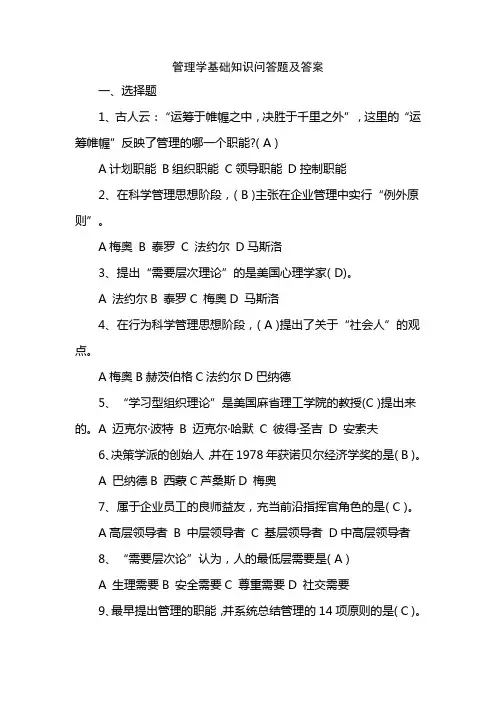
管理学基础知识问答题及答案一、选择题1、古人云:“运筹于帷幄之中,决胜于千里之外”,这里的“运筹帷幄”反映了管理的哪一个职能?( A )A计划职能B组织职能C领导职能D控制职能2、在科学管理思想阶段,( B )主张在企业管理中实行“例外原则”。
A梅奥B 泰罗C 法约尔D马斯洛3、提出“需要层次理论”的是美国心理学家( D)。
A 法约尔B 泰罗C 梅奥D 马斯洛4、在行为科学管理思想阶段,( A )提出了关于“社会人”的观点。
A梅奥B赫茨伯格C法约尔D巴纳德5、“学习型组织理论”是美国麻省理工学院的教授(C )提出来的。
A 迈克尔·波特B 迈克尔·哈默C 彼得·圣吉D 安索夫6、决策学派的创始人,并在1978年获诺贝尔经济学奖的是( B )。
A 巴纳德B 西蒙C芦桑斯D 梅奥7、属于企业员工的良师益友,充当前沿指挥官角色的是( C )。
A高层领导者B 中层领导者C 基层领导者D中高层领导者8、“需要层次论”认为,人的最低层需要是( A )A 生理需要B 安全需要C 尊重需要D 社交需要9、最早提出管理的职能,并系统总结管理的14项原则的是( C )。
A 欧文B泰罗C法约尔D韦伯10、企业管理的基本职能不包括( B )。
A 计划B指导C控制D 组织11“企业再造”是美国麻省理工学院的教授提出来的。
他是(A)A 迈克尔*哈默B 彼得*圣吉C 巴纳德D 马斯洛12、提出“双因素论”的是美国著名的心理学家( B )。
A马斯洛B赫茨伯格C梅赛D玛素13、在何种情况下,金钱可以成为“激励因素”,而不是“保健因素”( C )A 那些未达到最低生活标准,急于要养家糊口的人的计件工资。
B 组织在个人取得额外成就而很快给予的奖金。
C 以上两种情况均可使金钱成为“激励因素”。
D 无论什么情况下金钱都只是“保健因素”。
14、生产车间的工段长、班组长属于( C )。
A高层管理者B 中层管理者C 基层管理者D中高层管理者15、人际技能是( D)应具备的技能。
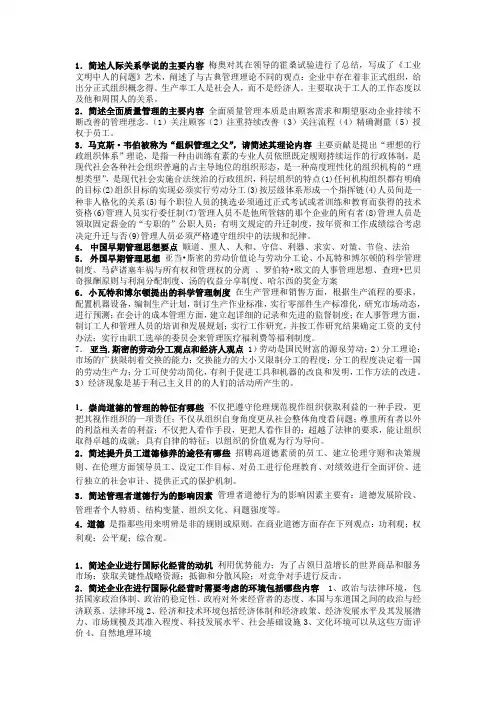
1.简述人际关系学说的主要内容梅奥对其在领导的霍桑试验进行了总结,写成了《工业文明中人的问题》艺术,阐述了与古典管理理论不同的观点:企业中存在着非正式组织,给出分正式组织概念得。
生产率工人是社会人,而不是经济人。
主要取决于工人的工作态度以及他和周围人的关系。
2.简述全面质量管理的主要内容全面质量管理本质是由顾客需求和期望驱动企业持续不断改善的管理理念。
(1)关注顾客(2)注重持续改善(3)关注流程(4)精确测量(5)授权于员工。
3.马克斯·韦伯被称为“组织管理之父”,请简述其理论内容主要贡献是提出“理想的行政组织体系”理论,是指一种由训练有素的专业人员依照既定规则持续运作的行政体制,是现代社会各种社会组织普遍的占主导地位的组织形态,是一种高度理性化的组织机构的“理想类型”,是现代社会实施合法统治的行政组织,科层组织的特点(1)任何机构组织都有明确的目标(2)组织目标的实现必须实行劳动分工(3)按层级体系形成一个指挥链(4)人员间是一种非人格化的关系(5)每个职位人员的挑选必须通过正式考试或者训练和教育而获得的技术资格(6)管理人员实行委任制(7)管理人员不是他所管辖的那个企业的所有者(8)管理人员是领取固定薪金的“专职的”公职人员;有明文规定的升迁制度,按年资和工作成绩综合考虑决定升迁与否(9)管理人员必须严格遵守组织中的法规和纪律。
4.中国早期管理思想要点顺道、重人、人和、守信、利器、求实、对策、节俭、法治5.外国早期管理思想亚当•斯密的劳动价值论与劳动分工论、小瓦特和博尔顿的科学管理制度、马萨诸塞车祸与所有权和管理权的分离、罗伯特•欧文的人事管理思想、查理•巴贝奇报酬原则与利润分配制度、汤的收益分享制度、哈尔西的奖金方案6.小瓦特和博尔顿提出的科学管理制度在生产管理和销售方面,根据生产流程的要求,配置机器设备,编制生产计划,制订生产作业标准,实行零部件生产标准化,研究市场动态,进行预测;在会计的成本管理方面,建立起详细的记录和先进的监督制度;在人事管理方面,制订工人和管理人员的培训和发展规划;实行工作研究,并按工作研究结果确定工资的支付办法;实行由职工选举的委员会来管理医疗福利费等福利制度。
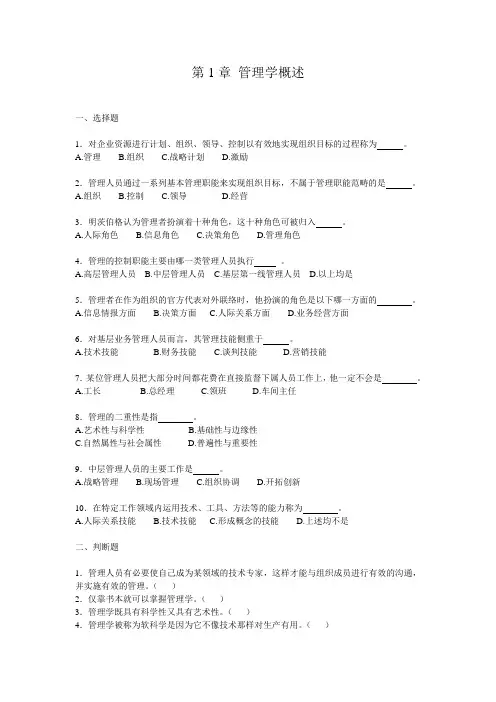
第1章管理学概述一、选择题1.对企业资源进行计划、组织、领导、控制以有效地实现组织目标的过程称为。
A.管理 B.组织 C.战略计划 D.激励2.管理人员通过一系列基本管理职能来实现组织目标,不属于管理职能范畴的是。
A.组织B.控制C.领导D.经营3.明茨伯格认为管理者扮演着十种角色,这十种角色可被归入。
A.人际角色B.信息角色C.决策角色D.管理角色4.管理的控制职能主要由哪一类管理人员执行。
A.高层管理人员B.中层管理人员C.基层第一线管理人员D.以上均是5.管理者在作为组织的官方代表对外联络时,他扮演的角色是以下哪一方面的。
A.信息情报方面B.决策方面C.人际关系方面D.业务经营方面6.对基层业务管理人员而言,其管理技能侧重于。
A.技术技能B.财务技能C.谈判技能D.营销技能7.某位管理人员把大部分时间都花费在直接监督下属人员工作上,他一定不会是。
A.工长B.总经理C.领班D.车间主任8.管理的二重性是指。
A.艺术性与科学性B.基础性与边缘性C.自然属性与社会属性D.普遍性与重要性9.中层管理人员的主要工作是。
A.战略管理B.现场管理C.组织协调D.开拓创新10.在特定工作领域内运用技术、工具、方法等的能力称为。
A.人际关系技能B.技术技能C.形成概念的技能D.上述均不是二、判断题1.管理人员有必要使自己成为某领域的技术专家,这样才能与组织成员进行有效的沟通,并实施有效的管理。
()2.仅靠书本就可以掌握管理学。
()3.管理学既具有科学性又具有艺术性。
()4.管理学被称为软科学是因为它不像技术那样对生产有用。
()5.概念技能成为所有成功管理工作中最为重要的技能。
()三、简答题1.简述各种管理职能的表现形式及相互关系是什么?2.管理者扮演的角色有哪些?必须具备哪些技能?3.怎样理解管理既是一门科学,又是一门艺术的含义?4.请从管理组织层和管理专业领域两方面给管理人员分类。
5.简述管理学的研究对象和研究方法。
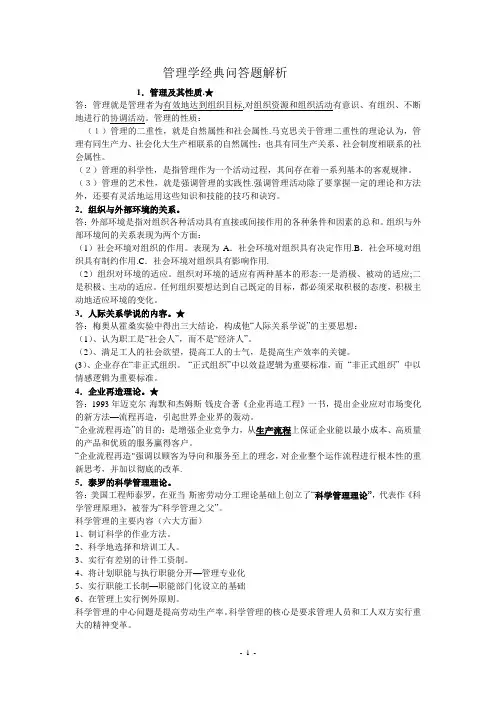
管理学经典问答题解析1.管理及其性质.★答:管理就是管理者为有效地达到组织目标,对组织资源和组织活动有意识、有组织、不断地进行的协调活动。
管理的性质:(1)管理的二重性,就是自然属性和社会属性.马克思关于管理二重性的理论认为,管理有同生产力、社会化大生产相联系的自然属性;也具有同生产关系、社会制度相联系的社会属性。
(2)管理的科学性,是指管理作为一个活动过程,其间存在着一系列基本的客观规律。
(3)管理的艺术性,就是强调管理的实践性.强调管理活动除了要掌握一定的理论和方法外,还要有灵活地运用这些知识和技能的技巧和诀窍。
2.组织与外部环境的关系。
答:外部环境是指对组织各种活动具有直接或间接作用的各种条件和因素的总和。
组织与外部环境间的关系表现为两个方面:(1)社会环境对组织的作用。
表现为A.社会环境对组织具有决定作用.B.社会环境对组织具有制约作用.C.社会环境对组织具有影响作用.(2)组织对环境的适应。
组织对环境的适应有两种基本的形态:一是消极、被动的适应;二是积极、主动的适应。
任何组织要想达到自己既定的目标,都必须采取积极的态度,积极主动地适应环境的变化。
3.人际关系学说的内容。
★答:梅奥从霍桑实验中得出三大结论,构成他“人际关系学说”的主要思想:(1)、认为职工是“社会人”,而不是“经济人”。
(2)、满足工人的社会欲望,提高工人的士气,是提高生产效率的关键。
(3)、企业存在“非正式组织。
“正式组织”中以效益逻辑为重要标准,而“非正式组织”中以情感逻辑为重要标准。
4.企业再造理论。
★答:1993年迈克尔·海默和杰姆斯·钱皮合著《企业再造工程》一书,提出企业应对市场变化的新方法—流程再造,引起世界企业界的轰动。
“企业流程再造”的目的:是增强企业竞争力,从生产流程上保证企业能以最小成本、高质量的产品和优质的服务赢得客户。
“企业流程再造"强调以顾客为导向和服务至上的理念,对企业整个运作流程进行根本性的重新思考,并加以彻底的改革.5.泰罗的科学管理理论。
管理学考试试题及答案一、选择题1. 以下哪个不属于管理的基本职能?A. 计划B. 组织C. 领导D. 监督答案:D2. 管理的本质是什么?A. 实现目标B. 解决问题C. 确保效率D. 优化资源分配答案:B3. 以下哪个不是有效沟通的要素?A. 发送者B. 接收者D. 平台答案:D4. SWOT分析是管理中常用的工具,其中的SWOT是指什么?A. 优势、劣势、机会、威胁B. 产品、价格、推广、渠道C. 目标、策略、执行、评估D. 质量、成本、交付、员工答案:A5. 管理者在进行决策时,应当遵循的原则是什么?A. 战略优先B. 利益最大化C. 风险规避D. 公平公正答案:B二、判断题1. 法律法规是管理者在进行决策时重要的参考依据。
B. 错答案:A2. 组织结构是指管理者分配和协调工作的方式和形式。
A. 对B. 错答案:A三、问答题(请简要回答)1. 简述管理者的角色与职责之间的关系。
答:管理者的角色是指在组织中扮演的不同角色,如领导者、决策者、协调者等;而职责则是指管理者应该履行的职责和任务。
角色与职责之间存在密切的关系,管理者根据不同的角色,承担不同的职责。
例如,在领导者的角色下,管理者需要制定组织的目标并激励员工实现这些目标;在协调者的角色下,管理者需要协调不同部门之间的合作,确保工作的顺利进行。
2. 举例说明管理者在沟通中可能遇到的障碍以及如何解决这些障碍。
答:管理者在沟通中可能遇到的障碍包括语言障碍、文化差异、信息选择性等。
例如,当管理者需要与海外团队进行沟通时,语言障碍可能导致信息的误解或无法理解,这时可以通过提前准备一份简明扼要的演示文稿,利用视觉化工具辅助沟通,以便更好地传达信息。
另外,文化差异也可能导致沟通的障碍,此时管理者可以进行跨文化培训,增加对不同文化背景的了解,以更好地适应和理解对方的沟通方式和习惯。
3. 简要解释SWOT分析的作用以及如何进行SWOT分析。
答:SWOT分析是一种常用的管理工具,用于评估组织内部和外部的优势、劣势、机会和威胁。
《管理学》习题及参考答案目录习题一 (1)习题一参考答案 (5)习题二 (11)习题二参考答案 (12)习题三 (15)习题三参考答案 (18)习题四 (21)习题四参考答案 (24)习题五 (27)习题五参考答案 (33)习题六 (37)习题六参考答案 (40)习题七 (46)习题七参考答案 (50)习题八 (52)习题八参考答案 (56)习题九 (58)习题九参考答案 (62)习题十 (67)习题十参考答案 (73)习题十一 (76)习题十一参考答案 (79)习题十二 (82)习题十二参考答案 (85)习题一一、名词解释1、管理2、管理职能3、科学管理4、霍桑试验5、系统管理理论6、权变管理理论7、管理科学二、单项选择1、下列哪位管理学者提出“管理就是决策”的主张()A、赫伯特·A西蒙B、彼得·F·德鲁克C、弗雷德·E·费德勒D、弗里蒙特·E·卡斯特2、管理的核心是()A、处理组织内部资源的稀缺问题;B、处理与组织外部的关系C、处理各种人际关系;D、处理组织内部与组织外部的一致性关系3、管理具有与生产关系、与社会制度相联系的一面,这里是指()A、管理的自然属性B、管理的社会属性C、管理的科学性D、管理的艺术性4、管理者必须因地制宜地将管理知识与具体管理活动相结合,这里强调的是()A、管理的科学性B、管理的艺术性C、管理学的历史性D、管理学的实用性5、“X—Y”理论的代表人物是()A、麦格雷戈B、赫兹伯格C、梅奥D、马斯洛6、社会合作系统学派的代表人物是()A、法约尔B、西蒙C、巴纳德D、卢桑斯7、系统与权变理论把人看作是()A、经济人B、社会人C、自我实现人D、复杂人8、决策理论学派的代表人物是()A、巴纳德B、西蒙C、卡斯特D、卢桑斯三、多项选择1、管理的二重性是指()A、管理的自然属性B、管理的社会属性C、管理的科学性D、管理的艺术性2、下列关于管理过程的描述,正确的有()A、管理过程和管理职能是统一的B、管理过程和管理职能是分离的C、管理过程是动态中的管理D、管理过程中静态中的管理E、管理过程也是信息变换的过程3、管理学具有以下特征:()A、一般性B、综合性C、历史性D、实用性E、艺术性4、从科学的定义上讲,存在管理必须具备以下条件:()A、必须是两个人以上的集体活动B、必须是具有盈利动机的集体活动C、必须是正式组织D、必须是非正式组织E、必须具有一致认可的、自觉的目标5、赫兹伯格理论中的“双因素”是指()A、保健B、激励C、X理论D、Y理论6、以下哪些内容是法约尔提出的管理原则()A、统一指挥B、统一领导C、职能管理D、人员的团结7、“行为科学”的代表人物是()A、德鲁克B、马斯洛C、麦格雷戈D、西蒙8、古典管理理论的代表人物是()A、泰罗B、法约尔C、梅奥D、李嘉图四、填空1、管理二重性是指和。
什么是管理?(管理定义+内涵)定义:管理是指组织为了达到个人无法实现的目标,通过各项职能活动,合理分配、协调相关资源的过程。
内涵:①管理的载体是组织。
②管理的本质是合理分配和协调各种资源的过程,而不是其他。
③管理的对象是相关资源,即包括人力资源在内的一切可以调用的资源。
④管理的职能活动包括信息、决策、计划、组织、领导、控制和创新。
⑤管理的目的是为了实现既定的目标,而该目标仅凭单个人的力量是无法实现的,这也是建立组织的原因。
决策的定义:决策是管理者识别并解决问题的过程,或者管理者利用机会的过程。
(理解:决策的特点:决策的主体是管理者;决策的本质是一个过程;决策的目的是解决问题或利用机会)[2] 原则:决策遵循的是满意原则,而不是最优原则。
[3] 依据:管理者在决策时离不开信息。
信息的数量和质量直接影响决策水平。
要进行成本—收益分析。
只有在收集的信息所带来的收益超过为此而付出的成本时,才应该收集该信息。
[4] 过程:①诊断问题(识别机会)②明确目标③拟定方案④筛选方案⑤执行方案⑥评估效果。
决策的影响因素:①环境因素(稳定性、市场结构、买卖双方在市场的地位)②组织自身的因素(组织文化、组织的信息化程度、组织对环境的应变模式)③决策问题的性质(问题的紧迫性、重要性)④决策主体的因素(个人对待风险的态度、个人能力、个人价值观、决策群体的关系融洽程度)计划与决策的关系决策与计划是两个既相互区别,又相互联系的概念。
①区别:决策是对组织活动方向、内容以及方式的选择;计划则是对组织内部不同部门和不同成员在一定时期内的行动任务的具体安排。
②联系:决策是计划的前提,计划是决策的逻辑延续;在实际工作中,决策与计划是相互渗透的,有时甚至是不可分割地交织在一起的。
计划的性质①计划工作为实现组织目标服务;②是管理活动的桥梁,是组织、领导和控制等管理活动的基础;③计划工作具有普遍性和秩序性;④计划工作要追求效率(以最低的费用取得预期的成果,避免不必要的损失,并保持较高的效率)组织设计的任务:设计清晰的组织结构,规划和设计组织中各部门的职能和职权,确定组织中职能职权、参谋职权、直线职权的活动范围并编制职务说明书。
管理学基础领导组织沟通创新企业道德团队建设激励计划管理理论管理学试题一一、单项选择题(每小题2分,共20分)1.领班属于下列哪一类管理人员( )A.基层管理人员B.中层管理人员C.高层管理人员D.以上都不是2.沟通、了解、激励下属的管理技能是( )A.技术技能B.诊断技能C.人际关系技能D.分析技能3.法约尔提出了管理的()条原则A.六B.十四C.十三D.五4.以下组织文化的描述中,正确的是( )A.变化较慢,一旦形成便日趋加强B.变化较快,随时补充新的内容C.变化较慢,但每年都会抛弃一些过时的内容D.变化较快,特别是企业管理人员变更时5.近年来,由于国务院进行人事制度改革,一批政府官员卸任离开政府部门。
消息刚传开,他们中的不少人就成了企业争聘的对象。
一般说来,企业聘请他们是为了()A.改善企业的组织文化B.改善企业的组织环境C.提高企业的管理水平D.改善企业的技术水平6.决策过程的第一步是( )A.确定目标B.发现问题C.收集信息D.调查研究、分析情报资料、找出问题7.实行集中控制与分散经营的组织形式是( )A.直线制B.矩阵制C.分部制D.职能制8.工作轮换一般用于提高哪些人的技能?( )A.工程技术人员B.管理人员C.学徒D.普通职工9.以追随者对领导的认同感为基础的影响力是属于( )A.专家权力B.表率权力C.奖励权力D.强制权力E.法定权力10.“大棒”是最为传统的激励手段之一。
以下现象中不属于由“大棒”产生的消极效应的是( )A.消极怠工B.一切向钱看C.生产劣质产品D.对工作漠不关心二、多项选择题(每小题2分,共20分)1.卡茨认为一个主管人员至少应具备的基本技能有 ( )A.概念技能B.人事技能C.技术技能D.管理技能E.分析技能2.目标的作用是 ( )A.指明管理工作方向B.激励作用C.凝聚作用D.考核主管人员和员工绩效的客观标准3.越是组织的最高主管人员,所做出的决策越倾向于以下哪些决策( )A.非肯定性B.例行的C.非常规性D.战略型4.泰罗要求以前由工人承担的工作分成 ( )A.计划职能;由企业管理当局承担B.执行职能;由现场工人执行C.协调职能;有协调工人执行D.控制职能;有工厂工头承包5.“社会人”假设说明( )A.应该否定集体奖励制度B.应该以金钱和地位作为唯一的激励手段C.人们是由社会需求而引起的工作动机D.人们的工作效率随社会需求满足程度的提高而提高6.以下属于激励方式的有( )A.思想政治工作B.奖励C.职工参与管理D.健全规章制度7.目标管理可理解为( )A.是管理管理者的管理B.他强调“自我控制”C.是分权制的结果D.是一种提供考核标准的管理8.关于激励的含义正确的有( )A.人的行为是由动机所支配B.行为的基本过程就是一个激励的过程C.激励指导动机、引导行为指向目标的活动过程D.激励就是施以物质刺激9.企业所处的社会环境,具体包括( )A.人口B.教育与文化C.物质资源状况D.风俗习惯10.下列属于计划类型的是( )A.政策B.规则C.使命D.目标三、问答题(每小题8分,共40分)1.什么是组织的一般环境?应包括哪些内容?答.管理者在计划、组织、领导、控制时必须考虑这些因素,但相对具体环境通常影响要小一些。
一、管理活动与理论1明茨伯格认为管理者应扮演的角色:管理者扮演着十种角色,可被归入三大类:人际角色(代表人、领导者、联络者角色);信息角色(监督者、传播者、发言人角色);决策角色(企业家、干扰对付者、资源分配者、谈判者角)。
2卡茨研究认为管理者应具备的技能:管理者应具备三类技能:技术技能(管理者''运用其所监督的专业领域中的过程、惯例、技术和工具的能力);人际技能(“成功地与别人打交道并与别人沟通的能力”,包括对下属的领导能力和处理各种关系的能力);概念技能(“把观点设想出来并加以处理以及将关系抽象化的精神能力”)。
3亚当斯密why认为分工是增进劳动生产力的重要因素:1分工可以使劳动者专门从事一种单纯的操作,从而提高熟练程度、增进技能2可以减少劳动者的工作转换,节约时间3可以使劳动简化,使劳动者的注意力集中在一种特定对象上,有利于发现比较方便的工作方法,促进工具的改良和机器的发明。
4泰罗的科学管理理论内容:工作定额、标准化、能力与工作相适应、差别计件工资制、计划职能与执行职能相分离O5巴纳德认为经理人员的主要职能:1 建立并维护一个信息系统2促使组织中每个人都能做出贡献3明确组织的目的。
6巴纳德认为组织存在和发展的必备条件:明确的目标、协作的意愿和良好的沟通。
7非正式组织:企业成员在共同的工作过程中,相互之间必然产生共同的情感、态度和倾向,形成共同的行为准则和惯例,这就构成一个体系,成为非正式组织。
它以独特的情感、规范和倾向,左右着成员的行为。
8系统分析的一般步骤:1确定系统的最终目标,同时明确每个特定阶段的目标任务;2把研究对象视为一个整体、一个统一的系统,然后确定每个局部要解决的任务,研究它们之间以及它们与总体目标的相互关系和相互影响;3寻求完成总体目标以及各个局部任务的可供选择的方案;4对可供选择的方案进行分析和比较,选出最优方案;5实施组织所选的方案。
9所有权与管理权分离对管理的意义:首先,独立的管理职能和专业的管理人员正式得到承认,管理不仅成为一种活动,还成为一种职业。
管理学简答题含答案名词解释1.企业目标是在分析企业外部环境和内部条件的基础上确定的企业各项经济活动的发展方向和奋斗目标,是企业经营思想的具体化。
2. 集权与分权集权是指决策权在组织系统中较高层次的一定程度的集中;分权是指决策权在组织系统中较低层次的一定程度的分散。
3. 前馈控制是指通过观察情况、收集整理信息、掌握规律、预测趋势,正确预计未来可能出现的问题,提前采取措施,将可能发生的偏差消除在萌芽状态中,为避免在未来不同发展阶段可能出现的问题而事先采取的措施。
4.全面质量管理就是指企业内部的全体员工都参与到企业产品质量和工作质量工作过程中,把企业的经营管理理念、专业操作和开发技术、各种统计与会计手段方法等结合起来,在企业中普遍建立从研究开发、新产品设计、外购原材料、生产加工,到产品销售、售后服务等环节的贯穿企业生产经营活动全过程的质量管理体系。
5.正式沟通是指按照组织明文规定的原则、方式进行的信息传递与交流,如组织内的文件传达、定期召开的会议、上下级之间的定期汇报以及组织间的公函来往等。
1、简述管理概念和性质答:①管理的二重性,即自然属性和社会属性。
首先,管理是生产社会化引起的,因此具有同生产力和社会化大生产相联系的自然属性。
其次,管理又是与生产关系相联系的一种“监督劳动”,具有同社会制度相联系的社会属性。
②管理的科学性。
管理作为一个活动过程,其间存在着一系列基本的客观规律,要用科学的方法论来分析问题和解决问题。
③管理的艺术性。
艺术性强调的是管理的实践性。
它强调管理活动除了要掌握一定的理论和方法外,还要有灵活地运用这些知识和技能的技巧和诀窍。
2、组织外部环境的特征和构成因素答:①社会环境。
主要是指一个国家的人口数量、年龄结构、职业结构、民族构成和特性、生活习惯、道德风尚以及这个国家的历史和历史上形成的文化传统。
②政治环境。
主要包括国家的政权性质和社会制度,以及国家的路线、方针、政策、法律和规定等。
第一章WHO ARE MANAGERS?127.In a short essay, explain how the definition of a manager has changed over time. Provide an example that illustrates the current definition.AnswerManagers used to be defined as the organizational members who told others what to do and how to do it. In the past, it was easy to differentiate managers from nonmanagerial employees. Nonmanagers were organizational members who worked directly on a job or task and had no one reporting to them. Managers were those who supervised other employees.Today, the changing nature of organizations and work has blurred the distinction between managers and nonmanagerial employees. Many traditional nonmanagerial jobs now include managerial activities. For example, managerial responsibilities are shar ed by managers and team members at General Cable Corporation’s facility in Moose Jaw, Saskatchewan, Canada. Most of the employees at Moose Jaw are cross-trained and multi-skilled. Within a single shift, an employee can be a team leader, equipment operator, maintenance technician, quality inspector, or improvement planner.(easy; pp. 4-5)128.In a short essay, describe the similarities and differences between managerial and nonmanagerial positions in today’s work environment. Answera.Similarities—In today’s w ork force, both managers and nonmanagers may at times have responsibility forcertain managerial activities. In addition, like nonmanagerial employees, managers may carry out some duties that do not involve supervising others.b.Differences—A nonmanager’s job tends to be focused on personal achievement. By contrast, a manager’s jobis not about personal achievement but rather helping others to do their work. In addition, nonmanagers focus primarily on accomplishing specific tasks. Managers may have their own tasks to accomplish, but they also focus on coordinating the work of others.(easy; pp. 4-5)129.In a short essay, describe and provide examples of first-line, middle, and top managers.Answera.First-line managers are the lowest level of management and manage the work of nonmanagerial individualswho are directly involved with the production or creation of the organization’s products. First-line managers are often called supervisors, but may also be called line managers, office managers, or even foremen.b.Middle managers include all levels of management between the first-line level and the top level of theorganization. These managers manage the work of first-line managers and may have titles such as department head, project leader, plant manager, or division manager.c.Top managers are responsible for making organization-wide decisions and establishing the plans and goals thataffect the entire organization. These individuals typically have titles such as executive vice president, president, managing director, chief operating officer, chief executive officer, or chairman of the board.(easy; pp. 6-7)WHAT IS MANAGEMENT?130.In a short essay, discuss the difference between efficiency and effectiveness and include a specific example to support each concept. Answera.Efficiency refers to getting the most output from the least amount of inputs. Because managersdeal with scarce inputs—including resources such as people, money, and equipment—they are concerned with the efficient use of resources. For instance, at the HON Company plant in Cedartown, Georgia, where employees make and assemble steel and wooden office furniture, efficient manufacturing techniques were implemented by doing things such as cutting inventory levels, decreasing the amount of time to manufacture products, and lowering product reject rates.From this perspective, efficiency is often referred to as ―doing things right‖—that is, not wasting resources.b.Effectiveness is often described as ―doing the right things‖—that is, those work activities that will help theorganization reach its goals. For instance, at the HON factory, goals included meeting customers’ increasingly stringent needs, executing world-class manufacturing strategies, and making employee jobs easier and safer.Through various work methods and programs, these goals were pursued and achieved. Whereas efficiency is concerned with the means of getting things done, effectiveness is concerned with the ends, or attainment of organizational goals.(moderate; pp. 7-8)WHAT DO MANAGERS DO?131.In a short essay, list and explain the four basic functions of management.Answera.Planning—involves the process of defining goals, establishing strategies for achieving those goals, anddeveloping plans to integrate and coordinate activities.anizing—involves the process of determining what tasks are to be done, who is to do them, how the tasks are tobe grouped, who reports to whom, and where deci sions are to be made.c.Leading—when managers motivate subordinates, influence individuals or teams as they work, select the mosteffective communication channel, or deal in any way with employee behavior issues, they are leading.d.Controlling—to ensure that work is proceeding as it should, managers must monitor and evaluate performance.The process of monitoring, comparing, and correcting is what is meant by the controlling function. (moderate; pp. 8-9)132.In a short essay, list and discuss 7 of the 10 managerial roles developed by Mintzberg. Include specific examples of each role and group each according to interpersonal, informational, and decisional roles.AnswerInterpersonal Rolesa.Figurehead—symbolic head; obliged to perform a number of routine duties of a legal or social nature.Examples include greeting visitors and signing legal documents.b.Leader—responsible for the motivation and activation of subordinates; responsible for staffing, training, andassociated duties. Examples include performing virtually all activities that involve subordinates.c.Liaison—maintains self-developed network of outside contacts and informers who provide favors andinformation. Examples include acknowledging mail, doing external board work, and performing other activities that involve outsiders.Informational Rolesa.Monitor—seeks and receives wide variety of internal and external information to develop thoroughunderstanding of organization and environment. Examples inc lude reading periodicals and reports, and maintaining personal contacts.b.Disseminator—transmits information received from outsiders or from subordinates to members of theorganization. Examples include holding informational meetings and making phone calls to relay information.c.Spokesperson—transmits information to outsiders on organization’s plans, policies, actions, results, and so on.Examples include holding board meetings and giving information to the media.Decisional Rolesa.Entrepreneur—searches organization and its environment for opportunities and initiates ―improvementprojects‖ to bring about changes. Examples include organizing strategy and review sessions to develo p new programs.b.Disturbance handler—responsible for corrective action when organization faces important, unexpecteddisturbances. Examples include organizing strategy and review sessions that involve disturbances and crises.c.Resource allocator—responsible for the allocation of organizational resources of all kinds—making orapproving all significant organizational decisions. Examples include scheduling, requesting authorization;performing any activity that involves budgeting and the programming of subordin ates’ work.d.Negotiator—responsible for representing the organization at major negotiations. Examples includeparticipating in union contract negotiations.The interpersonal roles are roles that involve people and other duties that are ceremonial and symbolic in nature. The three interpersonal roles include being a figurehead, leader, and liaison. The informational roles involve receiving, collecting, and disseminating information. The three informational roles include a monitor, disseminator, and spokesperson. Finally, the decisional roles revolve around making choices. The four decisional roles include entrepreneur, disturbance handler, resource allocator, and negotiator.(difficult; pp. 10-11; AACSB: Communication)139.In a short essay, discuss which approach is more useful for describing the job of a manager—functions or roles? Describe the contributions of both approaches.AnswerFayol’s functions approach represents the most useful way of describing the manager’s job. This is because Fayol’s functions pro vide ―clear and discrete methods‖of classifying management activities and techniques. Though less effective than the functions approach, Mintzberg’s roles approach does offer important insights into managers’ work. Many of his roles align well with one or more of the functions. For instance, resource allocation is part of planning, as is the entrepreneurial role, and all three of the interpersonal roles are part of the leading function.(moderate; p. 12)140.In a short essay, describe the three main types of managerial skills identified by Robert Katz. Which skills are most important to each level of management, and why?Answera.Research by Robert L. Katz concluded that managers needed three essential skills. These are technical skills,human skills, and conceptual skills. Technical skills are the job-specific knowledge and techniques needed to perform specific tasks proficiently. Human skills involve the ability to work well with other people both individually and in a group. Conceptual skills are the skills managers use to think and to conceptualize about abstract and complex situations.b.Technical skills tend to be more important for lower-level managers. This is because lower-level managerstypically manage employees who use tools and techniques to produc e the organization’s products and services.Human skills are equally important at all levels of management, because all managers must deal directly with people. Conceptual skills are most important at top levels of management. Managers at top levels must use conceptual skills to see the organization as a whole, to understand the relationships among various subunits, and to visualize how the organization fits into its broader environment.(moderate; pp. 12-13)140. In a short essay, describe the three main types of managerial skills identified by Robert Katz. Which skills are most important to each level of management, and why?Answera. Research by Robert L. Katz concluded that managers needed three essential skills. These are technical skills, human skills, and conceptual skills. Technical skills are the job-specific knowledge and techniques needed to perform specific tasks proficiently. Human skills involve the ability to work well with other people both individually and in a group. Conceptual skills are the skills managers use to think and to conceptualize about abstract and complex situations.b. Technical skills tend to be more important for lower-level managers. This is because lower-level managers typically manage employees who use tools and techni ques to produce the organization’s products and services. Human skills are equally important at all levels of management, because all managers must deal directly with people. Conceptual skills are most important at top levels of management. Managers at top levels must use conceptual skills to see the organization as a whole, to understand the relationships among various subunits, and to visualize how the organization fits into its broader environment.(moderate; pp. 12-13)WHY STUDY MANAGEMENT?141.In a short essay, discuss the importance of studying management.Next, list at least five rewards and five challenges of being a manager.AnswerBy studying management, you’ll be able to recognize poor management and work to correct it. In addition, you’ll be able to recognize good management and encourage it, whether it’s in an organization you’re simply interacting with or whether it’s in an organization where you’re employed. Another reason for studying management is the reality that for most students, once they graduate from college and begin their careers, they will either manage or be managed. A final reason to study management is the rewards and challenges of being a manager.Rewards of Being a Managera.most important work of an organization is creating a work environment in which organizational members canwork to the best of their abilityb.have opportunities to think creatively and use imaginationc.help others find meaning and fulfillment in workd.get to support, coach, and nurture otherse.get to work with a variety of peoplef.receive recognition and status in organization and communityg.play a role in influencing organizational outcomesh.receive appropriate compensation in the form of salaries, bonuses, and stock optionsi.good managers are needed by organizationsChallenges of Being a Managera.it’s hard workb.have to deal with a variety of personalitiesc.often have to make do with limited resourcesd.motivate workers in chaotic and uncertain situationse.be able to successfully blend knowledge, skills, ambitions, and experiences of a diverse work group (moderate; p. 21; Exhibit 1-11)第二章HISTORICAL BACKGROUND OF MANAGEMENT1.Which two historical events were especially significant to the study ofmanagement? Describe these events and discuss how they helped develop the management profession.AnswerTwo historical events are especially significant to the study of management. First, in 1776, Adam Smith published The Wealth of Nations, in which he argued the economic advantages that organizations and society would gain from the division of labor(or job specialization). The division of labor involved the breakdown of jobs into narrow and repetitive tasks. Smith’s work showed that division of labor increased productivity by increasing each worker’s skill and dexterity. I t also saved time lost in changing tasks, and it encouraged the development of labor-saving inventions and machinery. Division of labor continues to be popular as a principle for managing work.The second important event is the Industrial Revolution, which started in the late eighteenth century. During the Industrial Revolution, machine power was substituted for human power. This made it more economical to manufacture goods in factories rather than at home. The shift to factory work increased the need for management professionals. Large efficient factories needed managers to forecast demand and to ensure that enough material was on hand to make products. Managers were also needed to assign tasks to people and to direct daily activities. The increase in managers in turn necessitated the development of formal theories to guide managers in running large organizations.(moderate, pp. 28-29)SCIENTIFIC MANAGEMENT2.In a short essay, discuss Frederick T aylor’s work in scientificmanagement. Next, list T aylor’s four principles of management.AnswerFrederick Taylor did most of his work at the Midvale and Bethlehem Steel Companies in Pennsylvania. As a mechanical engineer with a Quaker and Puritan background, he was continually appalled by workers’ inefficiencie s.Employees used vastly different techniques to do the same job. They were inclined to ―take it easy‖ on the job, and Taylor believed that worker output was only about one-third of what was possible. V irtually no work standards existed. Workers were placed in jobs with little or no concern for matching their abilities and aptitudes with the tasks they were required to do. Managers and workers were in continual conflict. Taylor set out to correct the situation by applying the scientific method to shop floor jobs. He spent more than two decades passionately pursuing the ―one best way‖ for each job to be done.Taylor’s Four Principles of Managementa.Develop a science for each element of an individual’s work, which will replace the old rule-of-thumb method.b.Scientifically select and then train, teach, and develop the worker.c.Heartily cooperate with the workers so as to ensure that all work is done in accordance with the principles ofthe science that has been developed.d.Divide work and responsibility almost equally between management and workers. Management takes over allwork for which it is better fitted than the workers.(difficult; pp. 30-31)3.In a short essay, discuss the work in scientific management done byFrank and Lillian Gilbreth.AnswerFrank Gilbre th is probably best known for his experiments in bricklaying. By carefully analyzing the bricklayer’s job, he reduced the number of motions in laying exterior brick from 18 to about 5, and on laying interior brick the motions were reduced from 18 to 2. Usi ng the Gilbreth’s techniques, the bricklayer could be more productive on the job and less fatigued at the end of the day. The Gilbreths were among the first researchers to use motion pictures to study hand-and-body motions and the amount of time spent doing each motion. Wasted motions missed by the naked eye could be identified and eliminated. The Gilbreths also devised a classification scheme to label 17 basic hand motions, which they called therbligs. This scheme allowed the Gilbreths a more precise way of analyzing a worker’s exact hand movements.(moderate; pp. 31-32)GENERAL ADMINISTRATIVE THEORYS4.In a short essay, discuss the work of Henri Fayol as it relates to thegeneral administrative approach to management. Next, list and discuss7 of Fayol’s 14 principles of management.AnswerFayol described the practice of management as something distinct from accounting, finance, production, distribution, and other typical business functions. He argued that management was an activity common to allhuman endeavors in business, in government, and even in the home. He then proceeded to state 14 principles of management—fundamental rules of management that could be taught in schools and applied in all organizational situations.Fayol’s 14 Principles of Managemen ta.Division of work—specialization increases output by making employees more efficient.b.Authority—managers must be able to give orders. Authority gives them this right. Along with authority,however, goes responsibility.c.Discipline—employees must obey and respect the rules that govern the organization.d.Unity of command—every employee should receive orders from only one superior.e.Unity of direction—the organization should have a single plan of action to guide managers and workers.f.Subordination of individual interests to the general interest—the interests of any one employee or group ofemployees should not take precedence over the interests of the organization as a whole.g.Remuneration—workers must be paid a fair wage for their services.h.Centralization—thi s term refers to the degree to whi ch subordinates are involved in decision making.i.Scalar chain—the line of authority from top management to the lowest ranks in the scalar chain.j.Order—people and materials should be in the right place at the right time.k.Equity—managers should be kind and fair to their subordinates.l.Stability of tenure of personnel—management should provide orderly personnel planning and ensure that replacements are available to fill vacancies.m.Initiative—employees who are allowed to originate and carry out plans will exert high levels of effort.n.Esprit de corps—promoting team spirit will build harmony and unity within the organization.(difficult; p. 32-33)5.Describe the six elements of Max Weber’s model of bureaucracy.Explain the significance of each.AnswerIn Max Weber’s model, an ideal bureaucracy contains six elements. The first of these is a division of labor, through which jobs are broken down into simple, routine, and well-defined tasks. The second element is an authority hierarchy, in which job positions are organized within a clear chain of command. The third element is formal selection, through which personnel are selected for jobs based on their technical qualifications.The fourth element of Weber’s model is formal rules and regulations. Weber believed that a bureaucracy should be organized according to a system of written rules and standard operating procedures. Fifth, Weber believed that bureaucracies should be characterized by impersonality. Through this element, rules and controls could be applied in a uniform way, not according to individual personalities. Finally, Weber’s bureaucratic model includes a sixth element: career orientation. Weber saw managers not as owners of the units they manage, but instead as career professionals.(difficult; p. 32-34)TOWARD UNDERSTANDING ORGANIZATIONAL BEHAVIOR6.In a short essay, describe the Hawthorne Studies. Next, discuss the roleof Elton Mayo in these studies and list some of the findings of his research.AnswerWithout question, the most important contribution to the developing organizational behavior field came from theHawthorne Studies, a series of studies conducted at the Western Electric Company Works in Cicero, Illinois.Western Electric industrial engineers initially designed these studies as a scientific management experiment. They wanted to examine the effect of various illumination levels on worker productivity. Based on their research, it was concluded that illumination intensity was not directly related to group productivity. In 1927, the Western Electric engineers asked Harvard professor Elton Mayo and his associates to join the study as consultants. Through additional research, Elton Mayo concluded that group influences affected individual behavior, that group standards establish individual worker output, and that money is less a factor in determining output than are group standards, group sentiments, and security. These conclusions led to a new emphasis on the human behavior factor in the functioning of organizations and the attainment of their goals.(difficult; p. 37)THE SYSTEMS APPROACH7.In a short essay, explain three primary ways in which the systemsapproach contributes to our understanding of management.AnswerThe systems approach contributes to our understanding of management first by helping us to understand that organizations are made up of interdependent factors. As managers coordinate work activities in the various units of the organization, they must ensure that all of the interdependent units are working together so that the organization’s goals can be achieved. The systems approach recognizes that an organization’s overall performance is dependent upon the efforts of many units working together.Second, the systems approach helps us to understand that decisions and actions taken in one organizational area will affect others and vice versa. For example, if the purchasing department of a company doesn’t acquire the right quantity and quality of inputs, that company’s production department will not be able to do its job effectively.Third, the systems approach recognizes that organizations are not self-contained. They rely on their environments for essential inputs. They also use their environments as outlets to absorb their outputs. No organization can survive for long if it ignores government regulations, supplier relations, or the varied external constituencies upon which it depends.(difficult; pp. 38-39)THE CONTINGENCY APPROACH8.Describe four popular variables established by the contingencyapproach. Explain how each variable might affect management approaches in different organizations. Provide an example of each.AnswerOne important contingency variable is the size of an organization. As the size of an organization increases, so do the problems of coordination. For instance, the type of organization structure appropriate for an organization of 50,000 employees is likely to be inefficient for an organization of 50 employees. A very large organization might require a more hierarchical management structure. A small organization, on the other hand, might thrive with less hierarchy in its management structure.A second popular contingency variable concerns the routineness of task technology. To achieve its purpose, anorganization must use technology. Routine technologies require organizational structures, leadership styles, and control systems that differ from those required by customized or nonroutine technologies. An auto manufacturing plant, for instance, might use routine technologies such as robots to perform automated work. These robots wouldrequire a much different type of management than would be required within a service business, such as a fast food restaurant, where employees’ customer service performance must be supervised.A third contingency variable is environmental uncertainty. The degree of uncertainty caused by environmentalchanges influences the management process. What works best in a stable and predictable environment may be totally inappropriate in a rapidly changing and unpredictable environment. A company that is going through a merger, for instance, might require its managers to focus on helping employees cope with management transitions.A company that is in a more stable environment might encourage its managers to focus on employee productivityand company growth.A fourth contingency variable concerns individual differences. Individuals differ in terms of their desire forgrowth, autonomy, tolerance of ambiguity, and expectations. These and other individual differences are particularly important when managers select motivation techniques, leadership styles, and job designs. An individual who desires a great deal of autonomy on the job might need to be managed in a very ―hands off‖ style, for example. An individual who is very motivated by team success might need to have his or her work activities structured to involve a great deal of group interaction.(difficult; p. 40)CURRENT TRENDS AND ISSUES three ways in which globalization has changed the manager’sjob. Describe and provide an example of each.Answera. Working with people from different cultures. Even in your own country, you’re likely to find yourself workingwith bosses, peers, and other employees who were born or raised in different cultures. What motivates you may not motivate them. Or your style of communication may be direct and open, but they may find this approach uncomfortable and threatening. To work effectively with a group of diverse people, you’ll need to understand how their culture, geography, and religion have shaped their values, attitudes, and beliefs and adjust your management style accordingly.b. Coping with anticapitalist backlash. Capitalism’s emphasis on profits, efficiency, and growth may be generallyaccepted in the United States, Australia, and Hong Kong, but that emphasis is not nearly as popular in places like France, the Middle East, or the Scandinavian countries. Managers at global companies like Coca-Cola, McDonald’s, or Procter & Gamble have come to realize that economic values aren’t universally transferable.Management practices need to be modified to reflect the values of the different countries in which an organization operates.c. Movement of jobs to countries with low-cost labor. Globalization means businessescan hire, source, and sell wherever they want. It’s increasingly difficult for managers in economically advanced nations, where minimum wages are typically $6 or more an hour, to compete against companies who rely on workers from developing nations where labor is available for 30 cents an hour. It’s not by chance that a good portion ofAmericans wear clothes made in China, work on computers whose parts came from Thailand, and watch movies filmed in Canada. In a global economy, jobs tend to flow to places where lower costs provide businesses with a comparative advantage. The implication for managers is that they must be prepared to deal with the difficult task of balancing the interests of their organization as it looks for ways to keep costs low and remain competitive with their responsibilities to the communities within which they operate.(difficult; pp. 40-41)。